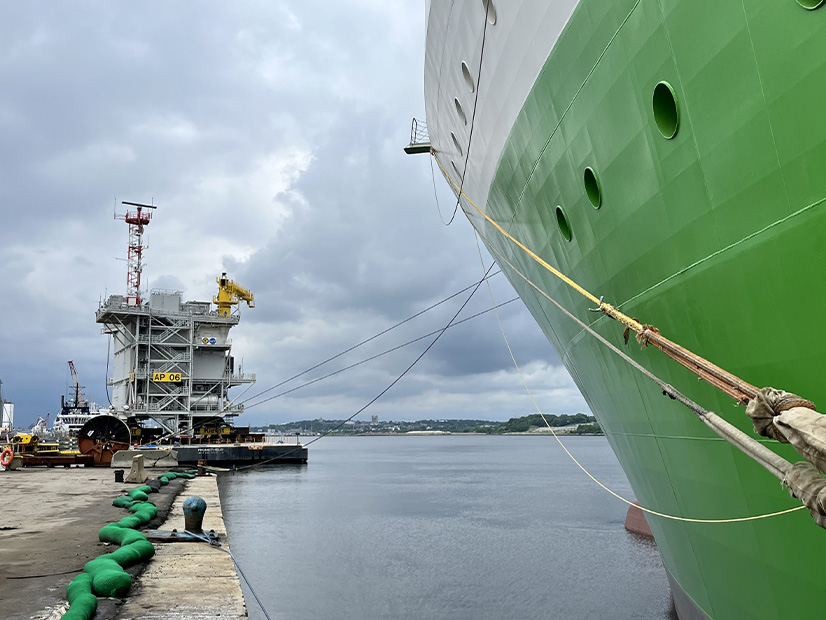
A new road map issued by an offshore wind trade association lays out the onshore infrastructure that could help the marine power source reach its potential in the United States.
The plan offered by the Business Network for Offshore Wind is neither modest nor inexpensive: It calls for $36 billion in spending on a network of up to 119 ports nationwide.
The U.S. offshore wind industry now has a mere 42-MW nameplate capacity but is poised to grow as state and federal leaders try to expand it to several dozen gigawatts by midcentury.
Spiraling costs are commanding headlines because they will filter down to consumers, but constraints on the supply chain and supporting infrastructure are just as problematic.
Monday’s report followed a separate but not unrelated announcement by the White House last week: Nine of the East Coast states at the center of first-generation offshore development efforts have signed a memorandum of understanding with four federal agencies to develop joint implementation plans to help the industry grow.
The goal is to expand manufacturing, port facilities, workforce development and supply chain capacity in a coordinated and sustainable way.
Port Buildout
BNOW in its report Monday underlined the need for public and private investment in port development and suggested ways to unlock the funds to accomplish this.
After more than a decade of study, development and delays, the U.S. offshore wind sector began to gain momentum in the past two years, culminating this year with the first substations and turbines being installed for the first two utility-scale projects in U.S. waters.
The industry ran into economic headwinds and the practical reality of creating an entire industry to fabricate and install supersized equipment under challenging conditions. Ports are on the shopping list.
“The shortage of port infrastructure developments is a critical bottleneck to industry growth that risks derailing progress,” BNOW President Liz Burdock said in a news release. “Federal and state governments must work together with private industry to incentivize and finance new offshore wind port projects to support our growing industry and create thousands of jobs in the process.”
BNOW identified 35 shoreline facilities in operation or in development and said more than $2.5 billion has been invested. But it placed the need at 99 to 119 ports along the Atlantic, Pacific and Gulf coasts. That breaks down into facilities specializing in pre-assembly; staging and integration; flexible laydown; manufacturing; and operations and maintenance.
BNOW suggests a mix of public- and private-sector steps to secure this investment, including state and federal subsidies, project de-risking strategies and accelerated permitting for construction projects.
BNOW said the investment would bring substantial returns: The 110 GW of offshore wind envisioned by 2050 carries an estimated $440 billion to $660 billion price tag in 2023 dollars, it said.
Regional Cooperation
Offshore wind is a signature initiative of President Biden, who has set a national goal of 30 GW online by 2030 and directed his administration to make progress toward it.
But states have a large regulatory role of their own in the buildout, as well as individual targets that add up to more than 30 GW.
The potential exists for competing and/or duplicated efforts if each state pursues its own priorities without coordinating with its neighbors.
The East Coast Memorandum of Understanding on Offshore Wind Supply Chain Collaboration announced Thursday includes Connecticut, Maine, Maryland, New Hampshire, New Jersey, New York, North Carolina, Rhode Island and the U.S. Departments of Commerce, Energy, Interior and Transportation.
The states will develop subregional plans to harness each other’s strengths and fill high-priority gaps while advancing economic development and environmental justice.
The Cabinet agencies will provide technical support to the states and help develop a share procurement and leasing timeline.
The Atlantic Coast from North Carolina to Massachusetts is the focus of early offshore wind development, because existing fixed-bottom turbine technology can be used there. Floating turbine technology still in development will be needed in the deeper waters off the Pacific coast and off Maine. To the south, the first Gulf of Mexico wind lease auction this summer fell flat.
But the White House said these early investments in the Northeast will bring future benefits of national scope, creating a viable U.S. supply chain for the new industry.
Also last week, the U.S. departments of Energy and Interior issued an action plan to build an interregional offshore transmission grid cable in Northeast and Mid-Atlantic waters.
The plan is a suggested road map for Northeast states to follow in the interest of reducing the price tag and increasing capacity.

